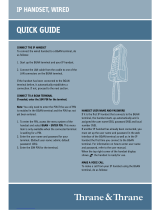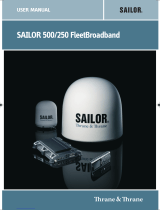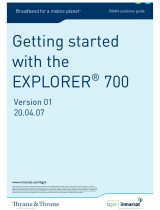Page is loading ...

KVH Industries, Inc.
User’s Guide
TracPhone
FleetBroadband
FB250 & FB500
®

TracPhone FB250 & FB500
User’s Guide
The KVH
®
Industries’ TracPhone
®
FB250/FB500 system, manufactured by
Thrane & Thrane, delivers high-speed data and voice communications via
satellite through Inmarsat’s Broadband Global Area Network (BGAN). This
user’s guide provides all of the information you need to operate, set up, and
troubleshoot the system. For detailed installation information, please refer to
the Installation Guide.
Please direct technical questions to:
North/South America, Australia: Europe, Middle East, Asia, Africa:
KVH Industries, Inc. KVH Europe A/S
50 Enterprise Center Kokkedal Industripark 2B
Middletown, RI 02842-5279 USA 2980 Kokkedal, Denmark
Tel: +1 401 847-3327 Tel: +45 45 160 180
Fax: +1 401 845-8133 Fax: +45 45 160 181
Internet: www.kvh.com Internet: www.kvh.com
If you have any comments regarding this manual, please e-mail them to
[email protected]. Your input is greatly appreciated!
Product Information
Before installing the TracPhone,
write down the following numbers:
SIM card #
Antenna serial #
Terminal serial #
KVH Part # 34-125645-G
© 2008-2012, KVH Industries, Inc., All rights reserved.
UG_Welcome_Page.fm Page 1 Tuesday, August 7, 2012 8:51 AM

Trademark Information
TracPhone, KVH, and the unique light-colored dome with dark contrasting
baseplate are registered trademarks of KVH Industries.
Thrane & Thrane is a registered trademark of Thrane & Thrane A/S in the
European Union and the United States.
Windows and Outlook are registered trademarks of Microsoft Corporation in
the United States and other countries.
Inmarsat is a registered trademark of International Maritime Satellite
Organisation (IMSO) and is licensed by IMSO to Inmarsat Limited and
Inmarsat Ventures plc.
Inmarsat’s product names are trademarks or registered trademarks of
Inmarsat.
All other trademarks are the property of their respective owners.
Disclaimer
Every effort has been made to ensure the correctness and completeness of the
material in this document. No company shall be liable for errors contained
herein. The information in this document is subject to change without notice.
No warranty of any kind is made with regard to this material, including, but
not limited to, the implied warranties of merchantability and fitness for a
particular purpose.
UG_Welcome_Page.fm Page 2 Tuesday, August 7, 2012 8:51 AM

iii
Safety summary 1
The following general safety precautions must be observed during all
phases of operation, service and repair of this equipment. Failure to comply
with these precautions or with specific warnings elsewhere in this manual
violates safety standards of design, manufacture and intended use of the
equipment. KVH Industries assumes no liability for the customer's failure to
comply with these requirements.
Observe marked areas
Under extreme heat conditions do not touch
areas of the terminal or antenna that are
marked with this symbol, as it may result in
injury.
Microwave radiation hazards
During transmission the antenna in this system
radiates Microwave Power.This radiation may be hazardous to humans close
to the antenna. During transmission, make sure that nobody gets closer than
the recommended minimum safety distance.
On the TracPhone FB500, the minimum safety
distance to the antenna panel on the focal line
is 1.3 m, based on a radiation level of 10 W/m
2
.
The radiation level is 100 W/m
2
at a distance of
0.4 m from the antenna panel. Refer to the
drawing on the next page.
Pour une antenne TracPhone FB500, la distance de sécurité minimale avec
le panneau de l'antenne sur l'axe focal est de 1.3 m, sur la base d'un niveau
de radiation émis de 10 W/m
2
. L'appareil génère un niveau de radiation de
100 W/m
2
à une distance de 0.4 m de l'avant du panneau de l'antenne.
Veuillez consulter le schéma sur la page suivante.

iv
On the TracPhone FB250, the minimum safety
distance to the antenna panel on the focal line
is 0.6 m, based on a radiation level of 10 W/m
2
.
The radiation level is 100 W/m
2
at a distance of
0.2 m from the antenna panel. Refer to the
drawing below.
Pour une antenne TracPhone FB250, la distance de sécurité minimale avec
le panneau de l'antenne sur l'axe focal est de 0.6 m, sur la base d'un niveau
de radiation émis de 10 W/m
2
. L'appareil génère un niveau de radiation de
100 W/m
2
à une distance de 0.2 m de l'avant du panneau de l'antenne.
Veuillez consulter le schéma au-dessous.
Distance to other equipment
Do not move the antenna closer to radars than the minimum safe distance
specified in the installation manual - it may cause damage to the antenna.
Compass Safe Distance:
TracPhone Terminal: min. 0.3 m.
TracPhone FB500 antenna: min. 1.0 m
TracPhone FB250 antenna: min. 1.1 m
FB500:
MICROWAVE RADIATION
No personnel within safety distance
25 for FB500
60 for FB250
Safety distance:
(0.4 m, 100 W/m
2
)
1.3 m, 10 W/m
2
FB250:
(0.2 m, 100 W/m
2
)
0.6 m, 10 W/m
2

v
Service
User access to the interior of the terminal is prohibited. Only a technician
authorized by KVH Industries may perform service - failure to comply with
this rule will void the warranty. Access to the interior of the antenna is
allowed, but only for replacement of certain modules - as described in the
Installation manual. General service may only be performed by a technician
authorized by KVH Industries.
Do not service or adjust alone
Do not attempt internal service or adjustments unless another person,
capable of rendering first aid resuscitation, is present.
Grounding, cables and connections
To minimize shock hazard, the equipment chassis and cabinet must be
connected to an electrical ground. The terminal must be grounded to the
ship. For further grounding information refer to the Installation manual.
Do not extend the cables beyond the lengths specified for the equipment.
The cable between the terminal and antenna can be extended if it complies
with the specified data concerning cable losses etc.
All cables for the TracPhone system are shielded and should not be affected
by magnetic fields. However, try to avoid running cables parallel to AC
wiring as it might cause malfunction of the equipment.
Power supply
The voltage range is 10.5 - 32 V DC; 14 A - 5.5 A. It is recommended that the
voltage is provided by the 24 V DC bus on the ship. Be aware of high start-up
peak current: 20 A@24 V, 5 ms.
If a 24 V DC power bus is not available, an external 115/230 VAC to 24 V DC
power supply can be used.
Do not operate in an explosive atmosphere
Do not operate the equipment in the presence of flammable gases or fumes.
Operation of any electrical equipment in such an environment constitutes a
definite safety hazard.
Keep away from live circuits
Operating personnel must not remove equipment covers. Component
replacement and internal adjustment must be made by qualified

vi
maintenance personnel. Do not replace components with the power cable
connected. Under certain conditions, dangerous voltages may exist even
with the power cable removed. To avoid injuries, always disconnect power
and discharge circuits before touching them.
Failure to comply with the rules above will void the warranty!

vii
About the manual 2
Intended readers
This manual is a user manual for the TracPhone FB500 system and
the TracPhone FB250 system. The readers of the manual include
anyone who is using or intends to use one of these two systems.
No specific skills are required to operate the TracPhone system.
However, it is important that you observe all safety requirements
listed in the beginning of this manual, and operate the system
according to the guidelines in this manual.
Most current version
This manual may not always reflect the latest software
functionality of your terminal. To obtain the latest version of the
manual, please visit www.kvh.com and download the latest
version from the FB250 or FB500 product page.
Manual overview
Note that this manual does not cover installation nor does it cover
how to use the IP handset that comes with the system. For
information on installation refer to the installation manual and for
information on the IP handset refer to the user manual for the IP
handset. Part numbers for both manuals are listed in the next
section.
This manual has the following chapters:
• Introduction contains a brief description of the system and an
overview of the BGAN services.
• Getting started explains how to insert SIM (Subscriber Identity
Module) card and start up the unit. It also contains a short
guide to making the first call.
• Operating the system explains how to use the system.
• Using the web interface explains how to use the built-in web
interface of the terminal for configuration and daily use, and

viii
describes the available menus and settings, including
advanced setup of interfaces.
• Troubleshooting contains a short troubleshooting guide and
explains how to update software. It also describes the functions
of the light indicators and the Reset button, and explains the
event messages that may show in the web interface. Further, it
gives information on where to get help if needed.
• Conformity contains declarations of conformity for the
TracPhone and the TracPhone 19” rack systems.
Related documents
The below list shows the documents related to this manual and to
the TracPhone FB500 and TracPhone FB250 systems.
Title and description
Document
number
TracPhone FB250 & FB500
Installation Guide
Explains how to install the TracPhone terminal,
the TracPhone FB500 antenna and the
TracPhone FB250 antenna.
34-125646
TracPhone FB250 & FB500
Quick Reference Guide
A short guide to the most important functions of
the TracPhone systems.
54-0554
TracPhone FleetBroadband IP Handset User’s
Guide
Explains the features and functions of the IP
handset. The IP handset works as a standard IP
handset, but also serves as a user interface for
the TracPhone systems.
34-126059

ix
Typography
In this manual, typography is used as indicated below:
Bold is used for the following purposes:
• To emphasize words.
Example: “Do not touch the antenna”.
• To indicate what the user should select in the user interface.
Example: “Select SETTINGS > LAN”.
Italic is used to emphasize the paragraph title in cross-references.
Example: “For further information, see Connecting Cables on
page...”.

xi
Table of Contents
Safety summary ................................................................iii
About the manual ............................................................. vii
Chapter 1 Introduction
Welcome ............................................................................ 1
Features and interfaces ......................................................3
Main units ..........................................................................4
The Inmarsat BGAN system .............................................. 10
Services and interfaces ......................................................16
Chapter 2 Getting started
Before you start ................................................................ 18
Starting up the terminal ...................................................20
Connecting the TracPhone FleetBroadband IP handset ....24
Connecting a computer ....................................................26
Entering the SIM PIN for the terminal ...............................28
Registering with the BGAN network ..................................31
Making the first call .........................................................34
Standard connection to the Internet (default) ...................36
Chapter 3 Operating the system
General ............................................................................39
Using a phone or fax machine ..........................................44
Multi-voice (optional) .......................................................60
Using a computer .............................................................65

Table of Contents
xii
Using the IP handset ........................................................76
Chapter 4 Using the web interface
Introduction .....................................................................78
Entering the SIM PIN in the web interface ........................83
Using the Dashboard ........................................................84
Using the phone book ..................................................... 88
Using the Call log .............................................................94
Handling SMS messages ..................................................97
Setting up the interfaces ................................................. 104
Managing LAN network users .......................................... 141
Uploading software .........................................................157
Selecting the preferred BGAN satellite ............................. 161
Selecting the language ................................................... 163
Administration ................................................................ 164
Help desk and diagnostic report ..................................... 194
Event logging and self test .............................................. 196
Site map ......................................................................... 198
Chapter 5 Troubleshooting
Getting support .............................................................. 199
Uploading software ........................................................200
Troubleshooting guide ................................................... 201
Status signalling .............................................................209
Logging of events ...........................................................228
Reset button ...................................................................229

Table of Contents
xiii
List of reserved IP subnets ...............................................231
Supported AT commands for PPPoE ............................... 232
App. A Conformity
TracPhone FB500 ........................................................... 237
TracPhone FB500 19" Rack ............................................. 239
TracPhone FB250 ............................................................241
TracPhone FB250 19" Rack ............................................. 243
Glossary .......................................................................................245
Index ........................................................................................251

1
Chapter 1
1111
Introduction
Introduction 1
Welcome
Congratulations on the purchase of your TracPhone system!
TracPhone FB500 and TracPhone FB250 are maritime broadband systems,
providing simultaneous high-speed data and voice communication via
satellite through the BGAN (Broadband Global Area Network).

Chapter 1: Introduction
2Welcome
Applications include:
• Internet browsing
•E-mail
• Phone and fax services
• Large file transfers
• Video conferencing and Streaming
• VPN (Virtual Private Network) access to corporate servers
This chapter has the following sections:
• Features and interfaces
• Main units
• The Inmarsat BGAN system
• Services and interfaces

Chapter 1: Introduction
Features and interfaces 3
1111
Introduction
Features and interfaces
The TracPhone system offers the following features and interfaces:
Simultaneous voice and data communication over BGAN
Full duplex, single or multi-user, up to:
TracPhone FB500: 492 kbps
TracPhone FB250: 284 kbps
Support for streaming IP at:
TracPhone FB500: 8, 16, 32, 64, 128 and 256 kbps
TracPhone FB250: 8, 16, 32, 64 and 128 kbps
ISDN (Integrated Services Digital Network) service, only TracPhone FB500:
64 kbps
Voice: Standard Voice (4 kbps) or 3.1 kHz Audio
Optional Multi-voice feature: up to 9 concurrent voice calls (max. 6 for
TracPhone FB250)
4 LAN (Local Area Network) ports with PoE (Power over Ethernet) for
computers, e-hubs, IP handsets etc.
2 Standard Phone/Fax ports for standard phones or fax machines
1 Euro ISDN port for ISDN phones or, for TracPhone FB500 only: G4 fax or
ISDN modem
1 L-Band output for connecting a broadcast receiver for maritime data
1 multi-purpose I/O connector with 5 configurable inputs/outputs
1 SIM slot for your BGAN SIM card
Built-in DHCP/NAT router
Built-in web interface allowing you to manage your phone book, messages
and calls, and customize the terminal to your specific needs
Input power: 10.5 - 32 V DC (14 A - 5.5 A)
CE certified

Chapter 1: Introduction
4Main units
Main units
TracPhone FB500/TracPhone FB250
The main difference between the TracPhone FB500 system and the
TracPhone FB250 system lies in the antenna.
• TracPhone FB500 uses an FB500 antenna, which is a maritime BGAN Class
8 antenna.
The FB500 antenna is larger and provides more bandwidth than the
antenna used for the TracPhone FB250 system.
• TracPhone FB250 uses a FB250 antenna, which is a medium size, maritime
BGAN Class 9 antenna.
The TracPhone FB500 system and the TracPhone FB250 system basically use
the same type of terminal, except that the TracPhone FB500 offers a few more
features than the TracPhone FB250. See Features and interfaces on page 3.
Units overview
The TracPhone FB500 system includes the following main units:
• TracPhone FB500 antenna
• TracPhone Terminal or
TracPhone 19" Rack Terminal
• TracPhone FleetBroadband IP Handset & Cradle, wired
The TracPhone FB250 system includes the following main units:
• TracPhone FB250 antenna
• TracPhoneTerminal or
TracPhone 19" Rack Terminal
• TracPhone FleetBroadband IP Handset & Cradle, wired

Chapter 1: Introduction
Main units 5
1111
Introduction
TracPhone antennas
TracPhone FB500 antenna
The TracPhone FB500 system uses the FB500 antenna, which is a maritime 3-
axis controlled BGAN antenna. The antenna contains all functions for satellite
tracking, including a GPS (Global Positioning System). A single coaxial cable
carries all RF communication, supply voltage and modem communication
between the antenna and the terminal.
For information on how to install the antenna, refer to the installation manual.
This antenna is larger and provides more bandwidth than the antenna used
for the TracPhone FB250 system.

Chapter 1: Introduction
6Main units
TracPhone FB250 antenna
The TracPhone FB250 system uses the FB250 antenna, which is a medium size
maritime 2-axis stabilized BGAN antenna.
For information on how to install the antenna, refer to the installation manual.

Chapter 1: Introduction
Main units 7
1111
Introduction
TracPhone terminal
Overview
Whether you have purchased a TracPhone FB500 system or a
TracPhone FB250 system, the terminal is basically the same. For this reason
this section covers both systems.
The TracPhone Terminal is the controlling unit in the TracPhone system. It
contains all user interfaces and LED indicators and stores configuration data.
The terminal is also available in a 19” Rack version. The 19” Rack terminal is
the same as the basic version, except for the housing which fits in a 19” rack
and has an additional power switch on the front panel.
For information on how to install the terminal, refer to the installation manual.
/




